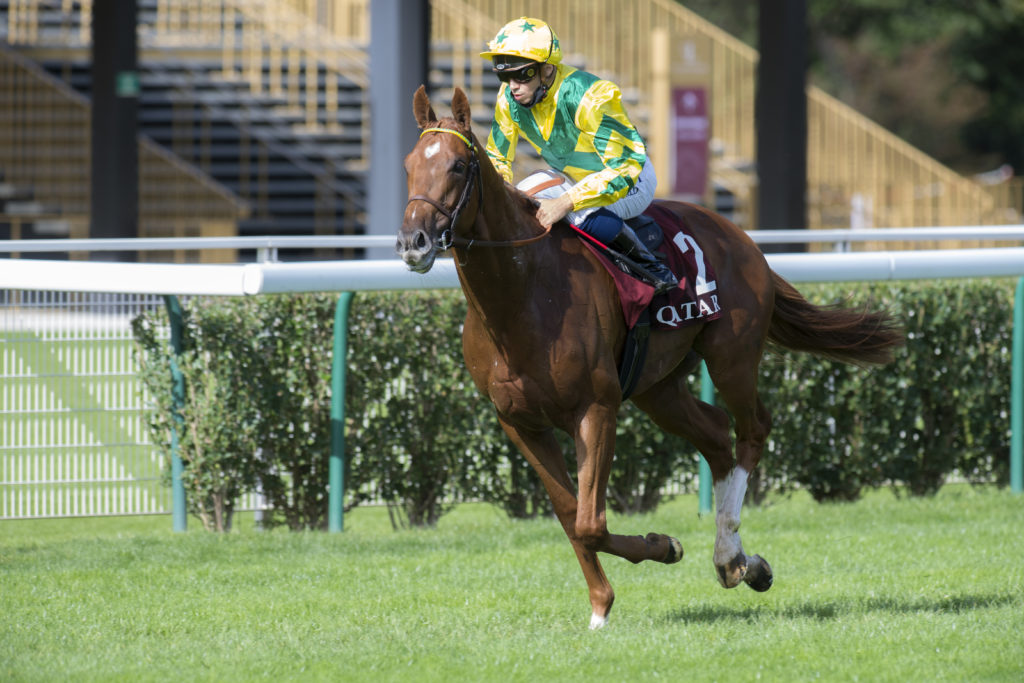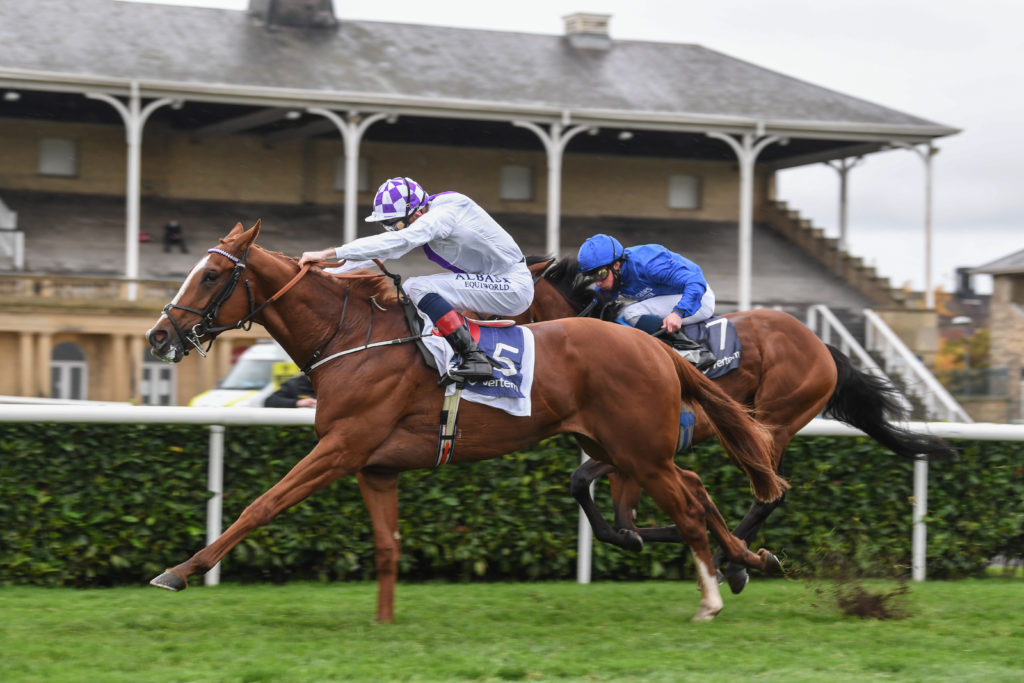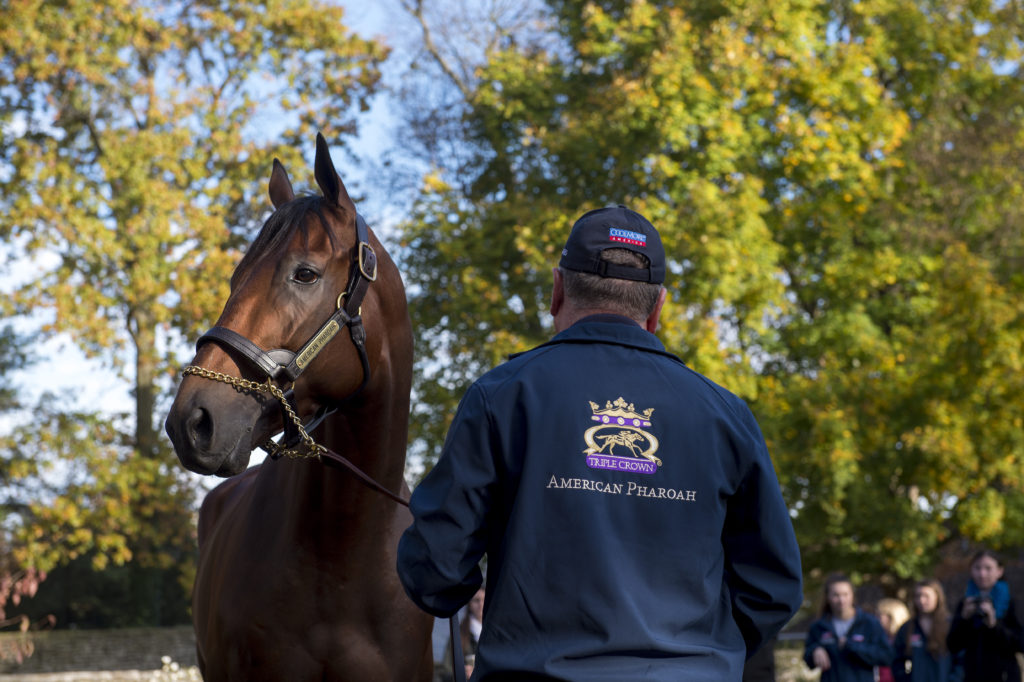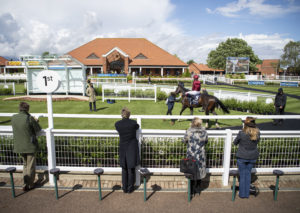As often as not, the Group 1 programme for two-year-olds in Europe produces at least one dual winner at the highest level, to give everyone a clearer idea of the generation’s champion. For example, in 2019 we saw Shamardal’s unbeaten sons Pinatubo and Earthlight achieve difficult Group 1 doubles, with Pinatubo taking the National and Dewhurst Stakes and Earthlight the Prix Morny and Middle Park Stakes.
Needless to say, there was little that was normal during the 2020 season, what with Covid and the contaminated food episode which forced the withdrawal of St Mark’s Basilica and Pretty Gorgeous from their Group 1 targets on Arc day. Fortunately, these two were able to race less than a week later, when Pretty Gorgeous took the Fillies’ Mile and St Mark’s Basilica the Dewhurst. It’s impossible to know whether they would have tried for further Group 1 glory had they been able to run and win at Longchamp, but the end result was that each of Europe’s 13 Group 1 events confined to two-year-olds had a different winner.
Remarkably, each of the 13 has a different sire and even their broodmare sires were largely different, the only duplication being Sadler’s Wells. Nearly 40 years after his birth, the perennial champion sire and holder of multiple broodmare sire championships added to his laurels as the broodmare sire of the Irish colts Thunder Moon and Van Gogh.
A May foal, Thunder Moon won a very competitive National Stakes on good going in September but was unable to confirm the form with third-placed St Mark’s Basilica when the two met again on soft ground in the Dewhurst, finishing third.
Sadler’s Wells also exerted his influence through his sons and grandsons, with Galileo inevitably leading the way. With 150 foals in his 2018 crop, Galileo had plenty of ammunition and his 26 juvenile winners made a bold attempt to provide him with his seventh juvenile sires’ championship. Although they fell short of that target, four of them – Shale, High Definition, Divinely and Lone Eagle – enjoyed Group success, something which just eluded Galileo’s smart son Wembley, runner-up in both the National and Dewhurst Stakes.
Shale contributed to Donnacha O’Brien’s eye-catching start to his training career with a pair of Group successes, most notably a victory over the future Fillies’ Mile winner Pretty Gorgeous in the Moyglare Stud Stakes. In becoming a Group 1 winner, Shale followed in the footsteps of her dam Homecoming Queen, who trounced the opposition as a 25/1 chance in the 2012 1,000 Guineas.

Sealiway, by Galiway, is another product of the Galileo/Danehill alliance – Photo: George Selwyn
Shale is yet another example of the exceptional results achieved by Galileo with mares from the Danehill male line, as her broodmare sire is Holy Roman Emperor. Galileo has 57 black-type winners out of Danehill mares, which equates to 18%, and he has six Group 1 winners, headed by the Classic winners Minding, Serpentine, Sovereign and The Gurkha, among his 23 black-type scorers out of Danehill Dancer mares. These equate to an impressive 19%.
Although Galileo has been mated to far fewer daughters of Holy Roman Emperor, they too have a high percentage of black-type winners, with their four stakes winners representing 17%. Shale is the only one of the four not produced by the prolific Inca Princess, dam of the Criterium International winner Johannes Vermeer, Group 2 winner Elizabeth Browning and Listed winner Sapa Inca. The aforementioned Wembley is the latest potential Group winner out of Inca Princess.
Galileo now has Group 1 winners out of mares by seven different sons of Danehill, the others being Desert King (Kew Gardens), Mozart (Magician), Rock of Gibraltar (Photo Call and Line of Duty), Dansili (Magic Wand) and Exceed And Excel. Exceed And Excel’s daughters could hardly have made a more impressive start with Galileo, as their four winners from five foals feature Derby winner Anthony van Dyck, the Group 1-winning Magic Attitude and her Group 2-winning sister Mission Impassible. That’s 60% Group winners.
In view of all the above, it is hardly surprising that the Galileo/Danehill alliance also played its part in 2020’s Group 1 two-year-old races. The Wertheimer-bred and -raced Galiway never managed to become one of the 38 Group winners sired by Galileo from Danehill’s daughters, but he did win a Listed race on his final appearance, having earlier been placed at Group 3 level Galiway’s bloodlines were strong enough to earn him a place at Haras de Colleville alongside the popular Kendargent, who had out-performed a similarly unexceptional racing career. Galiway has succeeded in siring a Group winner from each of his modestly-sized first two crops and both of them – Kenway and Sealiway – are out of Kendargent mares.
Mature enough to make a winning debut at Saint-Cloud in May, Sealiway progressed well, adding another three victories, most notably storming home by eight lengths from Nando Parrado on heavy ground in the Prix Jean-Luc Lagardere.
Bearing in mind that Sealiway was conceived at a fee of only €3,000, it would be unfair to expect a lot of black-type in his pedigree, but his dam Kensea won the Prix Herod, a Listed race over 1,400 metres, on very soft ground as a two-year-old.
Magic six for Teofilo
Few stallions made a bigger impact in 2020 than Teofilo, who first advertised the potential of the Galileo-Danehill cross by becoming Europe’s champion two-year- old in 2006. With six northern hemisphere-bred Group 1 winners to his credit during 2020, Teofilo did extremely well for a stallion priced at €30,000 in 2021, with one of the six being the two-year-old Gear Up. Sold by Jim Bolger’s Redmondstown Stud as a yearling, Gear Up has won three of his four juvenile starts, including the Acomb Stakes and Criterium de Saint-Cloud.
We shouldn’t be too surprised that Gear Up showed tremendous stamina and courage to repel repeated challenges over 2,000 metres at Saint-Cloud. Teofilo’s other Group 1 winners in 2020 included Subjectivist, winner of the Prix Royal-Oak over a distance just short of two miles, and Twilight Payment, who became his sire’s second winner of the Melbourne Cup with a heroic display over two miles.
Teofilo, of course, was bred and trained by Jim Bolger, as was his unraced daughter Halla Na Saoire, who has now supplied Bolger with Mac Swiney, winner of the Vertem Futurity on heavy ground at Doncaster.
Mac Swiney’s dam Halla Na Saoire is a sister to the Irish Derby third Light Heavy, as well as being a half-sister to Halla Siamsa, dam of Teofilo’s 2011 Dewhurst Stakes winner Parish Hall. Parish Hall became one of the first major winners inbred to Sadler’s Wells, with a son of Galileo as his sire and a daughter of Montjeu as his dam. And now Bolger has bred the first black-type winner closely inbred to the incomparable Galileo. To do so, Bolger sent his daughter of Teofilo to New Approach, whom Bolger had developed into a champion at two and three. Also a winner of the Futurity Stakes, Mac Swiney is inbred 2 x 3 to Galileo through two champions who jointly won 13 of their 16 starts
There have so far been a strictly limited number of runners inbred to Galileo, but it is a safe bet – following Mac Swiney’s emergence – that he will be just the tip of the iceberg. In addition to there being numerous highly-qualified sons of Galileo available to British and Irish breeders, there is also a growing number of young stallions with dams by Galileo, led by Darley’s Night of Thunder. This winner of the 2,000 Guineas has started so well that his fee has been raised from €25,000 to €75,000.

Mac Swiney: the latest star performer for his sire Teofilo – Photo: George Selwyn
The Coolmore stallion team includes two other 2,000 Guineas winners, Saxon Warrior and Magna Grecia, with dams by Galileo, as well as the Prix du Jockey-Club and Arc-winning Sottsass and top-class U S Navy Flag.
Tally-Ho Stud’s Galileo Gold, whose first crop races in 2021, is yet another 2,000 Guineas winner with a dam by Galileo. Ghaiyyath, an outstanding performer bred to the same pattern as Night of Thunder, has been retired to stand alongside him at Kildangan, increasing to seven the number of major winners out of Galileo mares at Irish studs.
That figure is likely to rise in a year’s time, as the Dewhurst Stakes winner St Mark’s Basilica is also owned by the Coolmore partners. A 1,300,000gns yearling, on the strength of his being a half-brother to Magna Grecia, St Mark’s Basilica is bred to the same pattern as Sottsass, both being sons of Siyouni. As Siyouni’s sire Pivotal and broodmare sire Danehill have both enjoyed highly fruitful associations with Galileo, it comes as little surprise that he too is thriving with daughters of the 12-time champion sire.
To conclude this section on the contribution of the Sadler’s Wells line, the four-length triumph of Van Gogh in the Criterium International highlighted that advancing years need not be a barrier to success in the equine world. In winning at Saint-Cloud, Van Gogh became the fifth Group winner, and tenth individual winner, produced by Sadler’s Wells’s excellent daughter Imagine. It was back in 2001 that Imagine won the Irish 1,000 Guineas prior to becoming the fourth of Sadler’s Wells’s five winners of the Oaks. Van Gogh was born when Imagine was 20 and Imagine herself was born when her sire Sadler’s Wells and dam Doff The Derby were 17. Doff The Derby, in turn, was born when her dam Margarethen was 19.
Imagine started her broodmare career in Ireland, where she produced three consecutive smart performers in Horatio Nelson (winner of the Prix Jean-Luc Lagardere), Red Rock Canyon (who established himself as a highly effective pacemaker, capable of hanging on for a place in Group 1 company) and Kitty Matcham (won Rockfel Stakes). Imagine’s next two Group/Graded winners – Viscount Nelson and Point Piper – were sired by Giant’s Causeway after her permanent move to the U.S. Imagine may not be finished yet, as she has a 2019 sister to Van Gogh.
International Pharoah
Whereas Imagine must be near the end of her broodmare career, Van Gogh’s sire American Pharoah appears to be on the verge of an exciting international career as a stallion. Although he seems to be held in a little less regard than Justify, Coolmore’s other American Triple Crown winner, it may prove relevant that the handicappers rated American Pharoah the better of the two by a comfortable margin: Timeform rated Justify 129, as opposed to American Pharoah’s 138.
I was sceptical whether American Pharoah, with his first three dams being daughters of Yankee Gentleman, Ecliptical and Tri Jet, had the pedigree to be as effective as a stallion as he had been on the racecourse. However, his exceptional talent, combined with his physique, action and temperament, seems to be compensating well for the blue-collar nature of the bottom half of his pedigree.
His first two crops have produced Group/Graded winners in Europe, the US and Japan. In Japan, his three-year-old sons Café Pharoah and Danon Pharaoh have been excelling on dirt, but plenty of others have been shining on turf in North America and Europe. In the US, his four Graded winners on turf include the Grade 1-winning Harvey’s Lil Goil and Four Wheel Drive, winner of the 2019 Breeders’ Cup Juvenile Turf Sprint. Van Gogh is his third Group winner in Europe, following Maven (Prix du Bois) and Pista, who landed the Park Hill Stakes prior to her second in the Prix de Royallieu. Other talented European runners include the Group 1-placed Monarch of Egypt and Listed winner Ocean Atlantique. Heavy ground doesn’t appear to faze the American Pharoahs.

American Pharoah: first two crops by Triple Crown hero have yielded Group/Graded winners in Europe, US and Japan – Photo: George Selwyn
Danehill impact
Inevitably the Danehill line also made an impact on the top two-year-old action in 2020. At the age of 12, Dansili’s son Zoffany cropped up not only as the sire of a two-year-old Group 1 winner – National Stakes winner Thunder Moon – but also as the broodmare sire of another, the Prix Marcel Boussac winner Tiger Tanaka.
This progressive filly is by Danehill’s son Clodovil, which means that she is inbred 2 x 4 to Danehill. Her dam, the minor two-year-old winner Miss Phillyjinks, belonged to Zoffany’s first crop.
Almost inevitably, Kodiac was the other son of Danehill to make an impact. Already a two-time champion sire of two-year-olds in Britain and Ireland, Kodiac added another nine juvenile black-type winners to his tally during 2020, including the Group scorers Campanelle (won Prix Morny and Queen Mary Stakes), Ubettabelieveit (Flying Childers Stakes), Nando Parrado (Coventry Stakes) and Umm Kulthum (Firth of Clyde Stakes).
Campanelle’s sire Kodiac, of course, is a three-parts-brother to Invincible Spirit, whose son Lawman was responsible for the Fillies’ Mile winner Pretty Gorgeous.
Coincidentally, there is another link between these leading two-year-old fillies. Campanelle’s dam, the two-year-old Listed winner Janina, is by Indian Ridge’s fast son Namid, whereas Pretty Gorgeous is out of Lady Gorgeous, a Listed-placed winner by Compton Place, another fast son of Indian Ridge.
Vega bucks the trend
Although the 2021 fees of many stallions have been revised downwards, one who bucked the trend was Lope de Vega, whose fee has risen for the seventh time in seven years. Back in 2014 he was available for €12,500, but breeders will have to pay ten times that amount in 2021. The constant increases in his fee have partly been fuelled by his ability to sire plenty of smart two-year-olds, which has also resulted in increased demand for his stock from American buyers.
The Ballylinch Stud stallion’s 2018 juveniles featured eight black-type winners, headed by Newspaperofrecord, Phoenix of Spain and Antonia de Vega, and the following year saw three more two-year-old Group winners in Lope Y Fernandez, Max Vega and Ecrivain. The latest season saw Aunt Pearl, Lucky Vega, Cadillac and La Barrosa all become Group/Graded winners. The unbeaten American filly Aunt Pearl showed great potential in landing the Breeders’ Cup Juvenile Fillies Turf, while Lucky Vega established himself as one of his sire’s fastest sons by easily winning the Phoenix Stakes and finishing a close second in the Middle Park.
I wrote about Mehmas, the champion first-crop sire, in another article a couple of months ago. The Middle Park Stakes provided a measure of his success, as he was represented by three of the market leaders. One of them, the Listed winner Method, performed below expectations but Supremacy added the historic Group 1 to his earlier success in the Richmond Stakes. Third place went to Mehmas’s Gimcrack Stakes winner Minzaal. It may be worth remembering that Mehmas’s first crop numbered nearly 150, but his next three crops are smaller, especially his 2020 crop, which is credited with 52 foals in the Return of Mares.
No Nay Never, sire of the Cheveley Park Stakes winner Alcohol Free, is another who doesn’t always have huge numbers on his side. Alcohol Free comes from a crop of around 100 and No Nay Never’s 2019 crop is slightly smaller. However, the tremendous success enjoyed by his first crop in 2018 translated into a 2019 book of 160 mares, for a crop of at least 123 foals, and he is credited with covering 193 mares in 2020, which was the first year he wasn’t shuttled to Australia.



